
The Art of Metalworking: Tradition, Innovation, and Practical Craft
Introduction
In ancient times, metalwork has a long and illustrious history of being made into masterpieces by India’s metal craftsmen. It’s about turning solid metal into useful objects, arts, and infrastructure—a simple transition that transcends the whole world of metalworking.
The richness of metal crafting is evident in Indian artistry, Japanese sword-making perfection, and the variety of African cultures. These have undoubtedly contributed to the development of different cultures and histories. It is the type of work of art that links us to our heritage and allows us to move into the future.
Metalworking’s origins
Metalworking’s roots date back centuries, crossing continent boundaries. From about 5000 years ago until now, the ancient craftsmen were hammering copper, iron, silver, bronze, and alloys into pretty and functional tools and art pieces.
Ancient metalworkers crafted metal into tools and weapons. Over time, the craft grew to accommodate not only funerary and practical items but also decorative and spiritual items. This shows that metalworking can adapt to changing society’s needs.
Diverse Techniques of Metalworking
Previous generations have passed down several methods used in Indian metalcraft. These techniques include brass casting, silver zardozi work, and goldsmithing, all of which show the diversity of metalworking. Yet they each have their separate place, making this craft unparalleled in precision and scalability.
- • Soldering and brazing methods involve combining metal pieces without fusing the base. The melting point of soldering filler metal is lower than that of brazing filler, which is slightly higher but stronger.
- • Engraving and etching involve cutting a design onto the metal surface. Etching creates designs using a chemical process, while engraving can be done manually or with a machine.
Traditions with Metalworking
- • Dhokra is a metalworking technique employing the lost-wax casting method from India. Artists across states create objects with primitive and tribal aesthetics in Chhattisgarh, Jharkhand, and West Bengal.
- • Sword smithing from Japan is known for its precision, involving folding metal multiple times. This creates a distinctive pattern and exceptionally sharp blades.
- • Silversmithing by Native Americans is known for incorporating stones into their designs. Particularly, the Navajo are celebrated for their exquisite silver jewellery.
In today’s digital age, techniques like 3D printing, CNC machining, and laser cutting allow proper precision with high scalability. Craftsmen and artists around the world still practice ancient methods by holding a mirror to the heritage and history of their communities.









